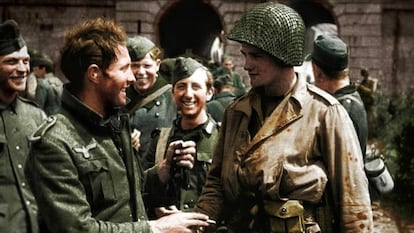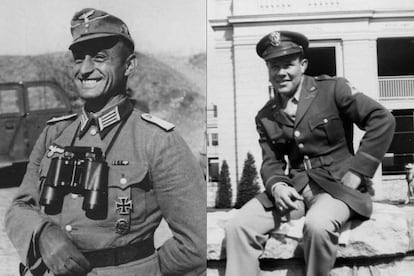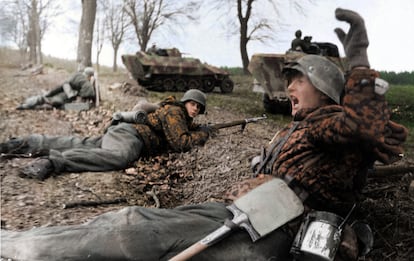
The World War II battle where German and US soldiers joined forces against the Waffen-SS
With Hitler dead and the Nazi surrender two days away, a ragtag unit of Wehrmacht and GIs banded together to defend illustrious French prisoners at the Battle for Castle Itter
Soldiers of the German regular army, the Wehrmacht, fighting against troops of the combat branch of the SS, the Waffen-SS, is something that perhaps we thought only happened in fiction. There are several examples, from Michael Caine’s parachute detachment squaring off with the SS in a fruitless attempt to save a young Jewish girl in The Eagle Has Landed to The Dirty Dozen, Where Eagles Dare and Tobruk to Quentin Tarantino’s Inglourious Basterds, but in many of these those doing the fighting are allied soldiers in German uniforms. In real life, Claus von Stauffenberg and his comrades in the July 20 plot killed several of their German officer peers in the failed attempt to assassinate Hitler at the Wolf’s Lair and to take control of Berlin in the foiled Operation Valkyrie plot involving high-ranking officers, designed to disarm the SS and trigger the arrest of the Nazi leadership. But none of these factual or fictional events involved a direct battlefield engagement.
The 2010 book The Crimes of the Wehrmacht dismantled the myth that the regular army were beyond reproach as opposed to the actions of the blood-stained SS and we know that the two often acted in unison, but the Battle of Castle Itter in Tyrol, Austria, was a verified case of Wehrmacht soldiers fighting the Waffen-SS in the field. During the closing stages of World War II, on May 5, 1945, with Hitler dead and Germany on the verge of surrender, US soldiers, Wehrmacht troops and French prisoners of war fought side by side against the 17th SS Panzergrenadier Division Götz von Berlichingen, whose striking name came from a 16th-century Imperial Franconian knight with an artificial iron hand, hence the unit’s emblem, and who is also credited with the first historically attested use of the expression “kiss my ass,” delivered to the Bishop of Bamberg, although this is another story.
Stephen Harding’s splendid 2020 book The Last Battle is the seminal work on the Battle of Castle Itter, a story that led the reviewer Andrew Roberts to wonder in his critique how on earth it managed to pass Steven Spielberg by given the similarities to Saving Private Ryan, where a small unit of men defend their positions against a numerically much superior force of Waffen-SS. “Part Where Eagles Dare, part The Guns of Navarone, this story is as exciting and as wacky as they come, yet unlike those iconic war movies, every word of The Last Battle is true,” Roberts noted.

The Battle for Castle Itter is a mind-blowing story and Harding’s meticulous reconstruction of events makes what occurred there even more astounding. Like Colditz, Itter also served as a prison during World War II and has a history stretching back to the 10th century involving witch hunts and where Liszt, Wagner, and Tchaikovsky all later boarded. In the 1920s it was converted into a luxury hotel and when the war broke out it was expropriated by the SS and turned into a POW camp in 1943. Colditz was reserved for the escape artists but Itter was for the rich and famous, and at the time held illustrious figures including Édouard Daladier, Paul Reynaud, Jean Borotra, Generals Maurice Gamelin and Maxime Weygand, Michel Clemenceau (son of former prime minister Georges) and Marie-Agnès Cailliau, née De Gaulle, the elder sister of the leader of Free France.
Located near the Dachau concentration camp, the castle was garrisoned by members of the SS-Totenkopfverbände, the feared Death’s Head Units, under the command of SS Captain Sebastian Wimmer, a sadistic brute who had previously been posted at the Majdanek concentration camp. His mission was to hold the French as hostages and possible bargaining chips, and to kill them as soon as he received orders to do so. When US troops arrived in the area amid rumors of an Alpine refuge where the most unyielding Nazis were holding out for a final confrontation, news reached them of the French prisoners in the castle, whose fate hung in the balance.
The situation in the area around Itter was complicated, with die-hard Waffen-SS units spoiling for a fight, seasoned Gebirsjäger mountain troops, Wehrmacht soldiers, Hitler Youth, civilian Volkstuurm, members of the Austrian anti-Nazi resistance armed by the British OSS and non-combatant civilians ready to raise the white flag all mingled together, plus a couple of imposing Tiger tanks.
This hodgepodge and uncertainty surrounding the longevity of the war led to the mess that was created around Castle Itter Castle, in which Wehrmacht Major Josef Gangl, a war hero decorated with the Iron Cross and the German cross in gold but inclined to end the war and avoid further suffering, played a decisive role. Gangl, who would later be honored as a hero of the Austrian resistance, was joined by Waffen-SS Captain Kurt-Siegfried Schrader, an experienced soldier who had fought at Leningrad, Caen and the Remagen Bridge and who was also disaffected with the Third Reich, and Nebraska tank commander John C. Lee, a former soccer player, a heavy drinker and another military veteran who had crossed half of Europe aboard his Sherman, christened Besotten Jenny. The three became strange and unlikely comrades-in-arms.

Inside the castle, the situation was deteriorating rapidly. Wimmer was in the process of fleeing with his SS guards; Schrader, who was in favor of surrendering the fortress, took command; the French prisoners were getting hold of weapons and Waffen-SS troops were converging on Itter; various attempts were made to contact the US forces to ask for help in rescuing the Gallic dignitaries. Eventually, after several attempts at parley, the occupants rallied to mount a defense of the castle. Gangl had 14 Wehrmacht officers and soldiers under his command. Lee had a dozen GIs and his tank, in addition to Waffen-SS Captain Schrader and the prisoners themselves.
So as not to confuse their own side with the enemy, the Germans wore a piece of black cloth on their left arms. Harding describes the incredible pre-battle scene in which two decorated officers of the Third Reich and the daring American tankman planned the defense of the medieval Tyrolean castle - the stuff of Alistair MacLean.
The siege of the castle began with bursts of MG-42 machine guns fired from the surrounding woods, to which the Sherman’s cannon, positioned to block the entrance to the fortress, responded. Meanwhile, another US force of the 142nd infantry advanced towards the castle along with two journalists who were not going to pass on such a big story. Their arrival was essential as the attacking Waffen-SS forces, numbering around 150 troops, had a deadly 88mm gun – a lethal tank destroyer – as well as a 75mm and a 20mm, the merciless meat grinder that appears in the battle of Ramelle at the end of Saving Private Ryan. During the crucial hours of the siege, Lee’s Sherman was destroyed by a shell, although the crew survived, and the heroic Gangl was hit in the head by a sniper’s bullet as he ran to get the politician Reynaud out of the line of fire.

Meanwhile, the most incredible messenger had been sent from the castle to contact the approaching US reinforcements, explain the situation to them and guide them in: the Frenchman Borotra, a four-times tennis Grand Slam champion as well as a politician, who was, logically, the fittest of the prisoners. He had also staged several escape attempts, so knew the lay of the land outside the castle walls. After boldly passing through the lines of the Waffen-SS, Borotra encountered possibly the last person he expected to see: the French-Canadian war correspondent René Levesque, a future Premier of Quebec, who was with the relief forces and immediately recognized Borotra. The rescue column, consisting of tanks, half-tracks, jeeps and troops, arrived at the castle just as the defenders were running out of ammunition. The first to spot them was one of the German soldiers defending the fortress who, upon seeing the Shermans shouted, alarmingly to his American comrades, “Panzer!” Faced with the arrival of a large enemy force, the Waffen-SS vanished into the woods.
The end of the battle for Castle Itter was somewhat anticlimactic: the French dignitaries were sent back to France, the American defenders were reintegrated into their units and the Germans who had fought alongside them were sent to prison camps. On May 7, Germany signed its unconditional surrender. Lee received the Distinguished Service Cross, the second highest US military decoration after the Medal of Honor, “for leadership and extraordinary heroism in action.” Gangl was recognized as an Austrian national hero for his alliance with the anti-Nazi resistance movement and his participation in the defense of the castle. A street in the neighboring town of Wörgl is named after him today. Wimmer, the SS camp commandant who escaped from the fortress, avoided a post-war reckoning at Nuremburg but committed suicide in 1952. Waffen-SS Captain Schrader was released and in 1953 took a job as a civil servant in the Ministry of the Interior of the state of Westphalia.
Sign up for our weekly newsletter to get more English-language news coverage from EL PAÍS USA Edition
Tu suscripción se está usando en otro dispositivo
¿Quieres añadir otro usuario a tu suscripción?
Si continúas leyendo en este dispositivo, no se podrá leer en el otro.
FlechaTu suscripción se está usando en otro dispositivo y solo puedes acceder a EL PAÍS desde un dispositivo a la vez.
Si quieres compartir tu cuenta, cambia tu suscripción a la modalidad Premium, así podrás añadir otro usuario. Cada uno accederá con su propia cuenta de email, lo que os permitirá personalizar vuestra experiencia en EL PAÍS.
¿Tienes una suscripción de empresa? Accede aquí para contratar más cuentas.
En el caso de no saber quién está usando tu cuenta, te recomendamos cambiar tu contraseña aquí.
Si decides continuar compartiendo tu cuenta, este mensaje se mostrará en tu dispositivo y en el de la otra persona que está usando tu cuenta de forma indefinida, afectando a tu experiencia de lectura. Puedes consultar aquí los términos y condiciones de la suscripción digital.
Archived In
Últimas noticias
Welcome to the post-religion era: The idea of Christianity as the absolute truth has become obsolete
‘I thought you would like it’: The risky sexual practice popularized by TV shows and TikTok
The digitalization of tourism: ‘They promise experiences and gave us the worst possible one’
Mexican peso defies uncertainty with forecasts of a new period of stability in 2026
Most viewed
- Sinaloa Cartel war is taking its toll on Los Chapitos
- Reinhard Genzel, Nobel laureate in physics: ‘One-minute videos will never give you the truth’
- Oona Chaplin: ‘I told James Cameron that I was living in a treehouse and starting a permaculture project with a friend’
- Why the price of coffee has skyrocketed: from Brazilian plantations to specialty coffee houses
- Silver prices are going crazy: This is what’s fueling the rally









































